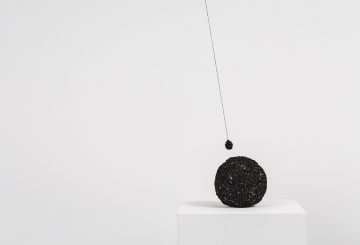Sharne Wolff took a trip across the river to Brisbane’s IMA and Mikala Dwyer’s recent solo show…
Last weekend the new exhibition Contemporary Australia: Women featuring more than 50 contemporary female artists opened at the Gallery of Modern Art (GoMA) in Brisbane. Meanwhile just across the river and not-too-far down the road in Brunswick Street, a solo exhibition and ‘mini retrospective’ by one of Australia’s better known contemporary artists, Mikala Dwyer, has recently wound up at the Institute of Modern Art (IMA). Despite the overwhelming presence of the GoMA on South Bank for the past 5 years the IMA has championed contemporary art in Queensland since its beginnings in 1975 and is Australia’s 2nd oldest contemporary art space.
Dwyer’s show was entitled ‘Drawing Down the Moon’ and comprised around ten large sculptural installations constructed from ‘three truckloads of junk’ alongside 2 video works originally made for the Biennale of Sydney in 2010 in conjunction with Justene Williams. (Incidentally, Williams wonderful new video installation entitled ‘Your boat my scenic personality of space 2012’ is included in the GoMA exhibiton).
Dwyer has been exhibiting since 1982 and has a CV almost as long as her ‘Moon 2009’ installation (see below). Her work has been shown at several Biennales and collected by almost every major Australian Gallery.
Entering the IMA space for Dwyer’s exhibition is not unlike entering one of those indoor playgrounds where parents take their kids to escape the rain. Everything is large, colourful and, at least at first glance, very welcoming. Some of the Gallery walls have been painted in bright primary colours, others are decorated with objects and there are striped totem poles, wooden sculptures and curios everywhere. Shiny silver helium balloons bob and float towards the back of the space. It’s an enchanting aesthetic presumably designed to encourage the relationship between art and audience.
Mikala Dwyer, Moon 2009, Appliqued Banner.
My first close encounter is with ‘Moon 2009’. It’s an oversize blue banner hung from the ceiling which continues to roll right across the Gallery floor. The banner has been hand appliquéd in text of various colours spelling out the names of the Lunar Maria (those parts of the moon’s surface that appear as ‘seas’ but are actually dark plains of basalt formed by ancient volcanic eruptions). The initials ‘G.R’ appear at the end of the banner. I’m certainly no astronomer but, having pondered that banner for a week or two, I had to do some investigating. It turns out that the mysterious ‘G.R.’ is the Italian astronomer and Jesuit priest, Giovanni Battista Riccioli, who introduced the modern naming system for the moon’s Maria in the late 17th century. His original nomenclature was obviously in Italian but the English translations are no less fascinating, whimsical and sublime – we are all familiar with the ‘Sea of Tranquility’ but who knew of the ‘Sea of Cleverness’, the ‘Sea of Crisis’, the ‘Lake of Excellence’ or the ‘Bay of Roughness’? These titles are synonymous with life itself. I can’t imagine ever looking at the moon in the same way again.
Although most of the installations in this show have been exhibited previously they are never reconstructed in exactly the same way. Dwyer has explored her ideas via different routes ranging from the occult in ‘Alphabet for Ghosts’ to the playful in ‘The Silvering’ and the peculiar in ‘Apparition of a Subtraction’. Also exhibited was the latest in the artist’s series of rather beautiful ‘necklaces’ commissioned for this show – ‘Wall Necklace 2012’. Each work is autonomous but together they seem to flirt for attention from the viewer. The crowded room works well for Dwyer as the viewer becomes disoriented with the space both in and around the works not quite knowing where one begins and another starts. Although there were (perhaps unfortunately) no children at the IMA on the day I viewed the exhibition it would have been interesting to observe if their lack of concern with social norms and ‘no no’s’ affected their reactions. It’s easy to imagine they would be more likely to accept the invitation to probe and question as the artist encouraged her adult audience to do.
Much of Dwyer’s latest work is concerned with the paranormal and the occult. In Alphabet for Ghosts, a Ouija board sized to human scale – with a moveable indicator on wheels – she created a place with a spiritual energy verging on the spooky (or perhaps that’s just me). The alphabet boards in the piece use the clean curves of the Bauhaus font apparently as a reference to women from the Bauhaus period.
In ‘Apparition of a Subtraction’ a series of totems, wooden triangles, columns, pieces of stone and various found objects and curios are arranged in a tight circle. The homemade or clunky appearance of many of the objects disappears into a work of overall harmony as each piece is given a new life within the work. It’s interesting the way the audience reacted to the piece, wandering around the outside, curiously peeking in and finding it difficult to physically enter the circle as if they will disturb whatever business may be going on inside. A bookshelf faced outward complete with old books and a few packets of cigarettes. Apparently it’s easier to interact with the piece from this angle and flick idly through the pages of a book (such as ‘Briefing for a Descent into Hell’) or smoke a cigarette as some people ostensibly managed to do at the opening.
Mikala Dwyer
‘Drawing Down the Moon’
Institute of Modern Art, Brisbane




Pingback: Mikala Dwyer ‘Drawing Down the Moon’ at Brisbane’s Institute of Modern Art. « Wolff.